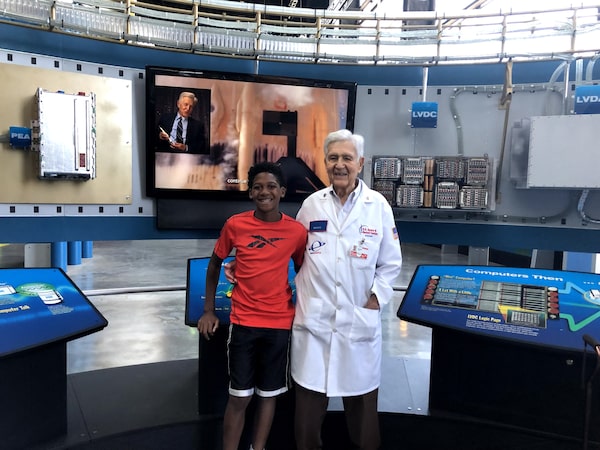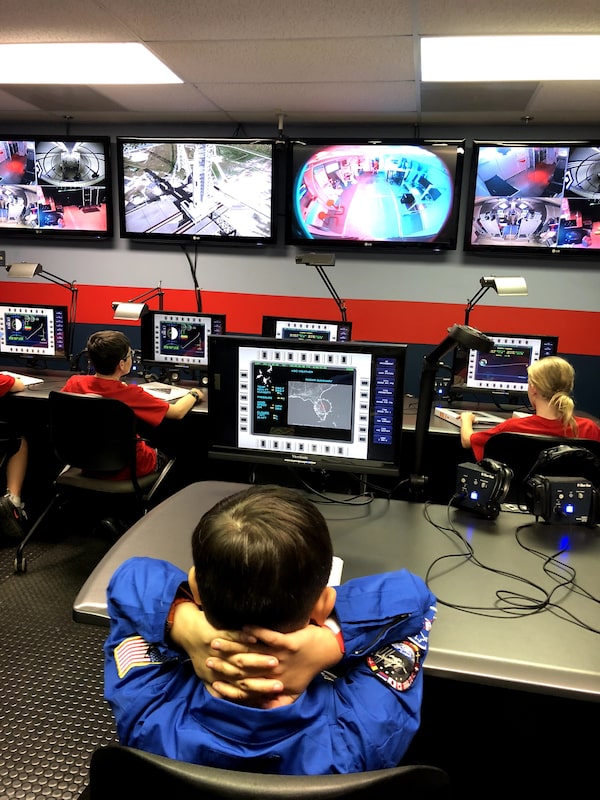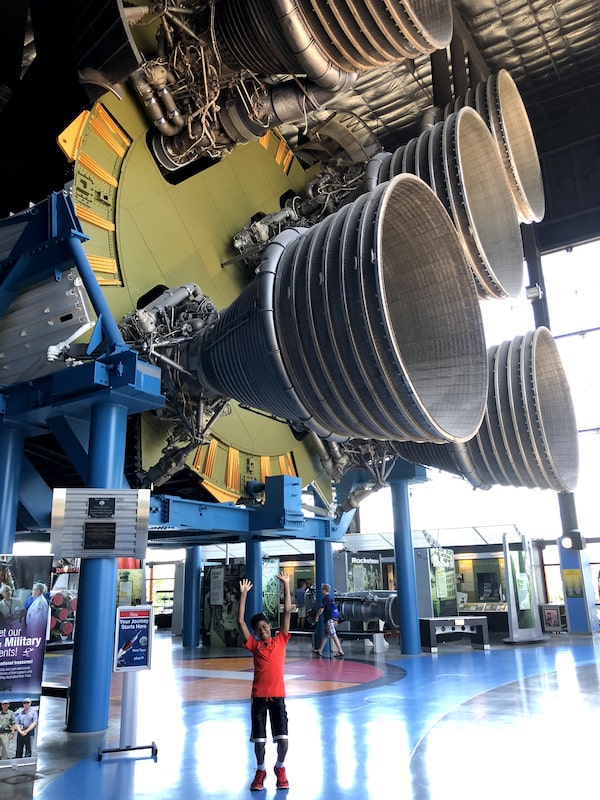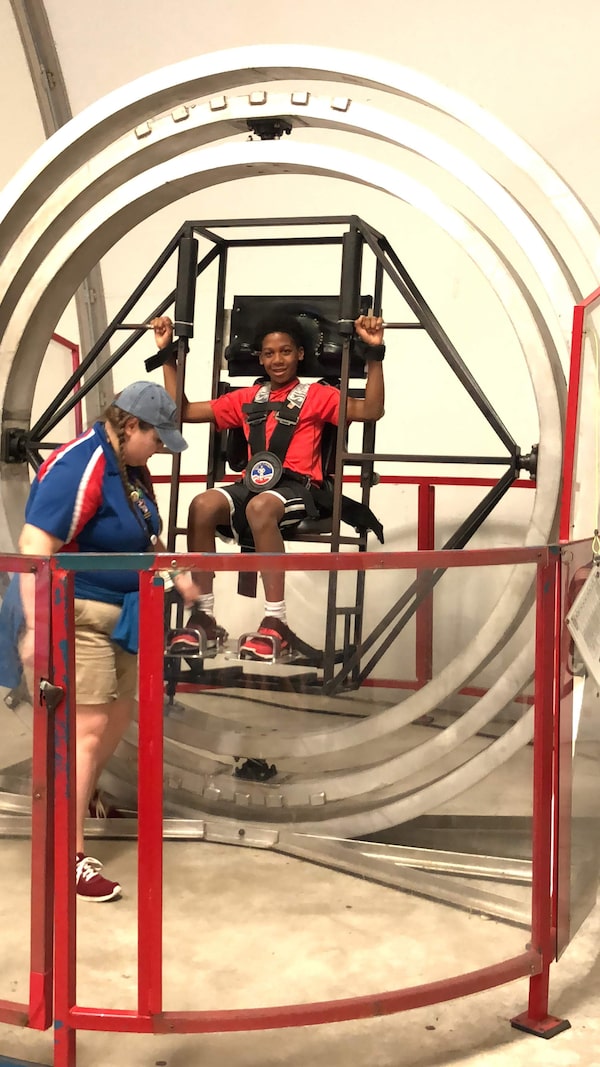
Cameron Davis poses with Brooks Moore, 92, in front of the Saturn V guidance and navigation system he helped create. The system helped send the Apollo missions into outer space.Heather Greenwood Davis
“Houston, we have a problem!”
There are fewer than a dozen kids with me in the Mission Control room at the U.S. Space and Rocket Center when I make that crack. None of them giggles, a few of them groan and my own son, Cameron, rolls his eyes.
I knew it was a risky joke when I made it. We aren’t in Houston, we are in Huntsville, Ala., and these kids don’t have time for wisecracks.
This is the first (and only official) space camp in the United States – with the registered trademark to prove it – and the brilliant kids whose parents fork out the US$999 to send them here for a week are too busy living their dreams to guffaw at a bad joke.
“They don’t have to be anyone but themselves here," explains Pat Ammons, the communications director who is showing us around. “It’s perfect for kids whose peers at school might not think science is cool. Here, they get validated for that.”
Kids and space have always gone together, but in this day and age when teamwork, resilience and STEM learning are part of parents’ educational dreams, space camp feels like the perfect response.

Kids study the monitors inside Mission Control at the U.S. Space and Rocket Center.Heather Greenwood Davis
The kids in the room with me each have manuals in front of them that detail how to replicate what would be happening in a real control room. Today’s mission involves landing a rover on Mars and harvesting hydrogen and oxygen from the planet. You know; kids’ stuff.
Out of the group of students only one says they want to be an astronaut when they grow up. “When I got to space camp, I realized engineers were problem solvers,” one girl tells us. “I want to solve problems.”
To say the program is popular would be a gross understatement. The week I’m visiting, 755 kids are taking part in the immersive camp. Roughly 900,000 kids from around the world have spent at least a night in the program since it launched in 1982.
But you don’t have to enroll in space camp or even be a kid to get something out of a visit.
The U.S. Space and Rocket Center is also a Smithsonian-affiliated museum that outlines the history of the American space program.

Around 900,000 children have come through the Alabama space camp since 1982.Heather Greenwood Davis
Surprised that all of this is happening in Alabama? You wouldn’t be the first.
Ammons acknowledges that most people are surprised to learn that Huntsville has one of the highest percentage of engineers in America.
“We put America on the moon,” Ammons says. “It’s the surprise story of a state not always known for heroic things.”
Huntsville’s connection to the moon mission started just after the Second World War. It was then that a team of German engineers went from developing ballistic rockets in Texas to becoming the backbone of NASA’s space program in Alabama. When in 1961, U.S. President John F. Kennedy announced the United States would have a man on the moon by the end of the decade, Huntsville had their marching orders.
Inside the on-site Davidson Center for Space Exploration, I meet one of the brilliant minds behind that movement. Brooks Moore was one of only two American engineers to become a lab director on that famous team.

Moore, right, is the oldest living member of the NASA team that put Apollo 11 into space.Heather Greenwood Davis
Now 92, Moore, dressed in a white lab coat and using a walker, is a docent emeritus showing off the guidance systems he designed (some by hand and on paper) for use in Saturn Rockets and Apollo missions.
“I’ve still got my slide rule.” Moore tells me with a grin as he shows me around.
In all, 13 Saturn V rockets would be launched during the program. The third in December, 1968 was the Apollo 8 that circled the moon. Six months later a Saturn V sent men to the moon.
This July will mark the 50th anniversary of that historic occasion.
Huntsville engineers are also responsible for the development of the lunar rover, the evolution of the space shuttle program and the first International Space Station. An original Saturn V Rocket is a designated National Historic Landmark on site and several Space Camp alumni have gone on to work for NASA, on and off the planet.

The multiaxis trainer was used to train astronauts in the 1960s and simulates what a spin through microgravity would feel like.Heather Greenwood Davis
It’s a fun place to hang out. We pass kids in space jumpsuits enjoying a variety of simulator experiences. Cameron tests out the multiaxis trainer and learns what it feels like to spin uncontrollably when re-entering Earth’s atmosphere. All of it has me a wee bit envious.
When Ammons tells me that along with camps for the visually and hearing impaired, they offer family camps where parents can join in, I perk up.
“We could do this,” I tell Cameron.
“It would be one small step for man, but a giant leap for Davis-kind!”
Not even Moore laughs at that one.
Need to Know: Admission to the Space Center for adults (13+) is US$25, kids (5-12) are US$17 and kids age 4 and under are free. Camp fees vary according to program. The commemorative Apollo: When We Went to the Moon exhibit runs through December. Rocketcenter.com
Disclosure: The writer’s trip to Alabama was supported in part by Brand USA, Alabama Travel, American Airlines and Marriott International. They did not review or approve this article.
Launch pads
Laval, Que.: This city is home to the only year-round space camp in Canada. Children ages 9 to 15 can participate in hands-on space training on virtual missions, robotics challenges, science workshops and space station like modules to sleep in! There are both daylong and overnight camp options. cosmodome.org
Houston: STEM activities take hold via space exploration and themed experiences for children as young as 4. Camps run throughout the year and “accessibility camps” offer those with special needs a chance to participate as well. spacecenter.org
Kennedy Space Center, Fla.: Camp KSC offers a choice of weeklong day camp experiences for children ages 7 to 16. Among them the all-new Astronaut Training Experience Center where you can try a microgravity spacewalk or practice docking your shuttle. kennedyspacecenter.com
Live your best. We have a daily Life & Arts newsletter, providing you with our latest stories on health, travel, food and culture. Sign up today.